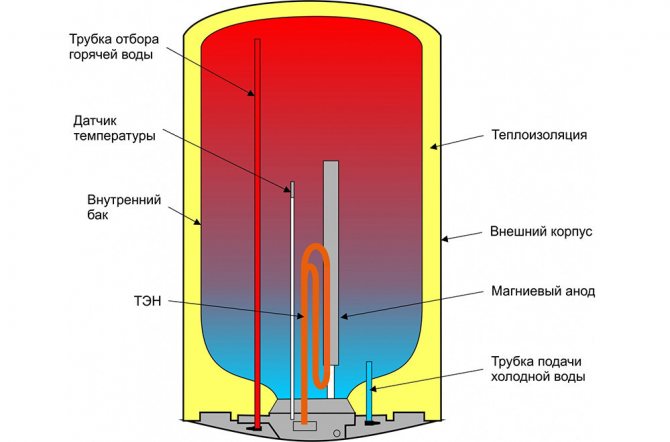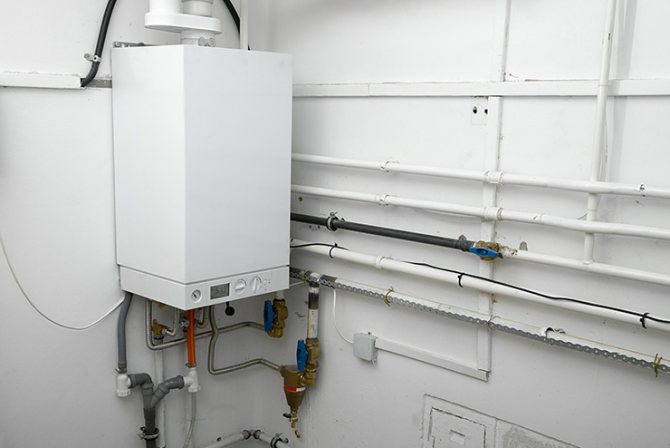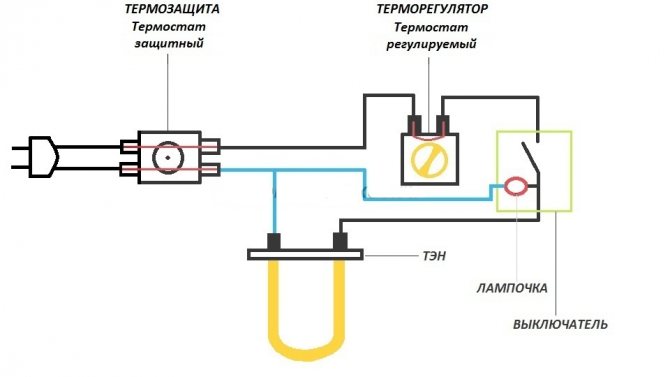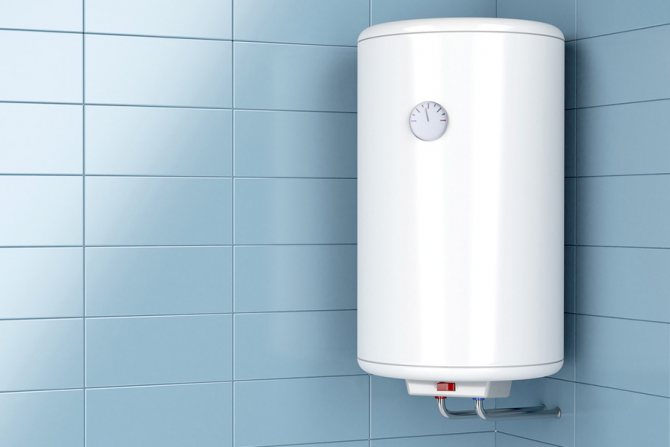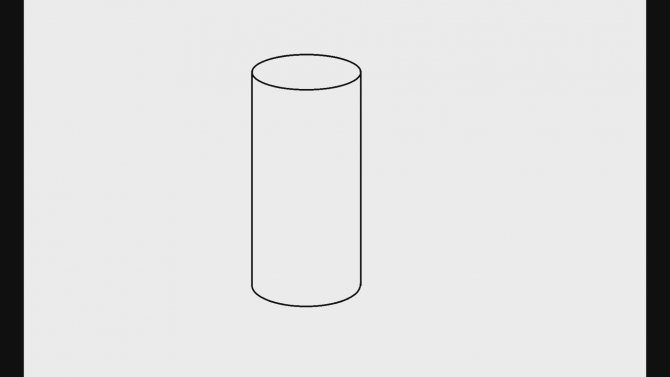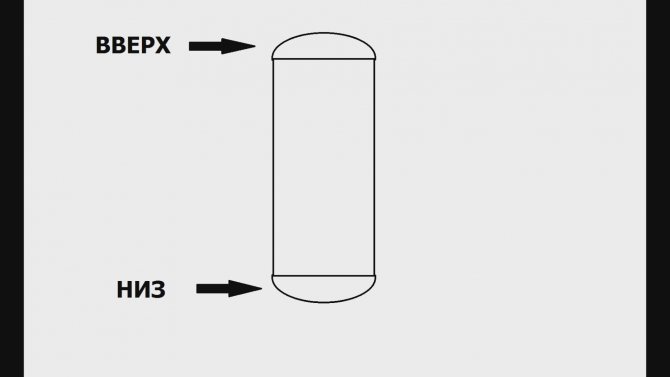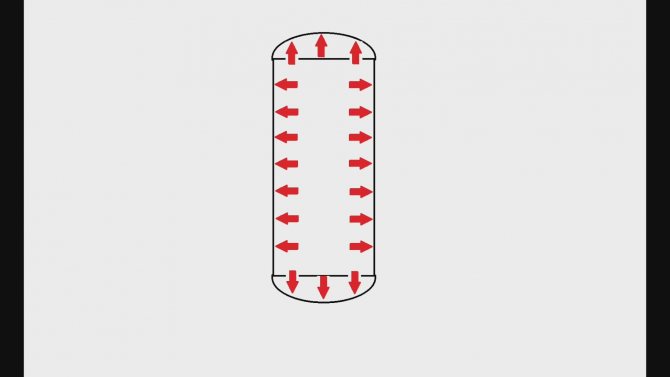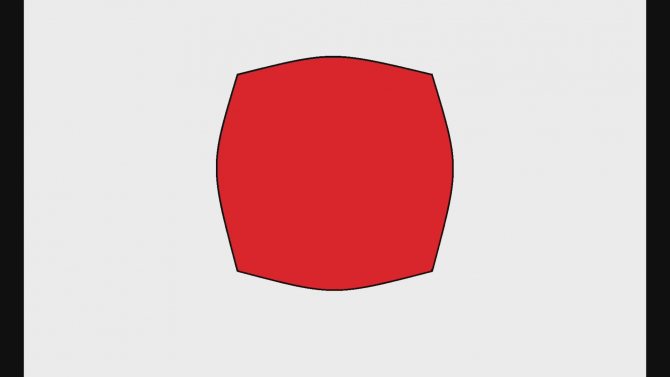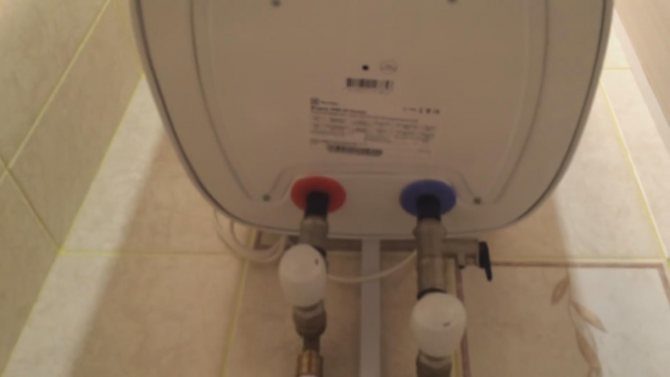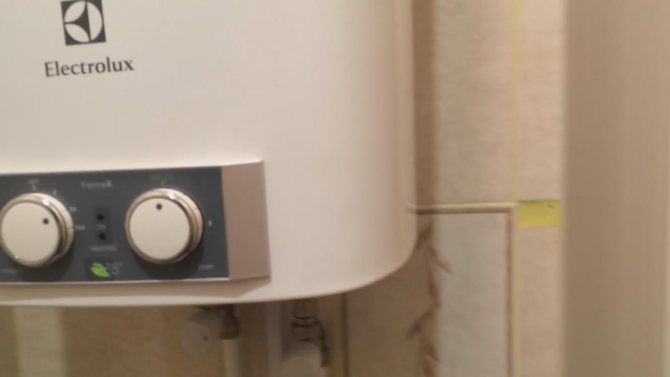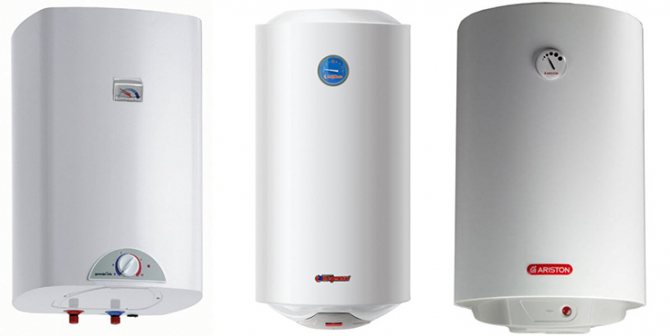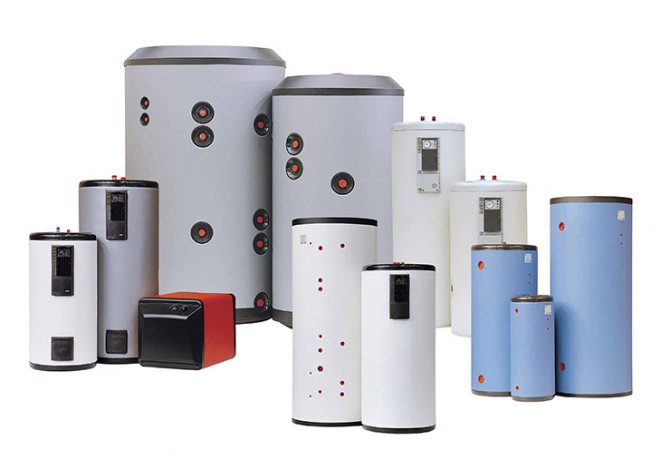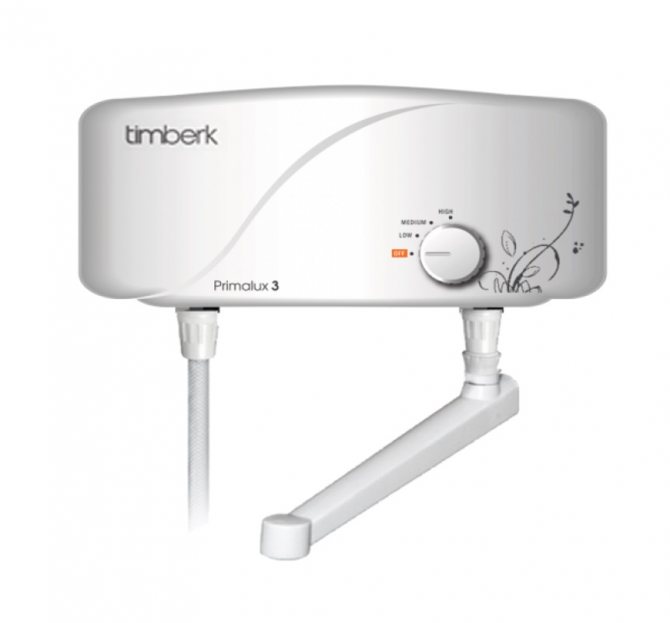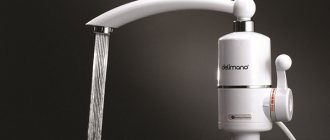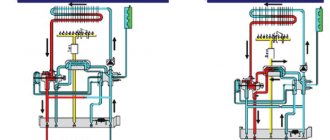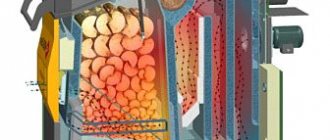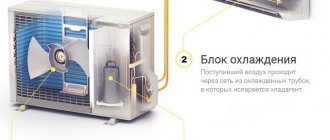Types of electric water heaters
The most economical way to heat cold water is to use a gas water heater, but in most cases this heating device is simply impossible to install. In multi-storey buildings, there are often no special systems for the disposal of natural gas combustion waste, and many private houses and summer cottages are not supplied with gas. Therefore, in this case, the installation of electrical appliances for obtaining hot water has no alternative. All electric water heaters are divided into only two types: storage (boilers) and flow-through. Below we will briefly review the principle of operation of each type separately.
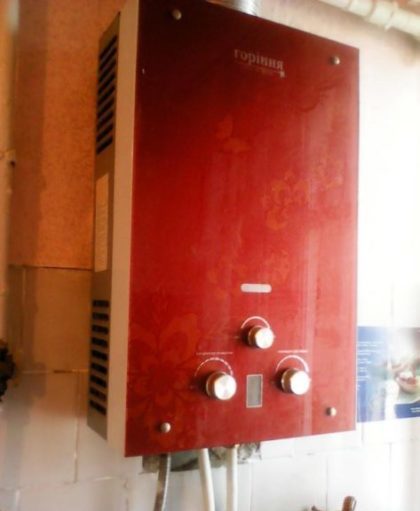
- Electric storage water heater (boiler). This device is most often called a boiler. The device is a simple water tank with installed heating elements (TENs) and electronic or mechanical control systems. The container itself is thermally insulated from the external environment, which significantly saves energy. The principle of operation of the storage water heater is static. The tank is filled with cold water and it is heated by heating elements. The whole process of heating and maintaining the required temperature takes place under the control of the automation unit.
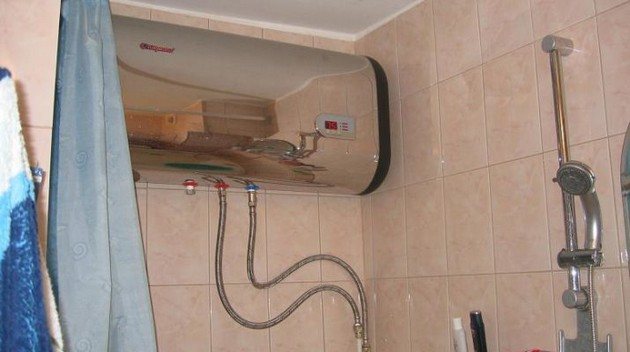

- Flowing electric water heater. The principle of operation of the instantaneous water heater is dynamic. This device does not have a cold water storage tank. The process of heating water by heating elements takes place in special pipes and coils with a constant flow of water through these elements. As in storage systems, in instantaneous water heaters, the principle of mechanical or automatic control using an electronic unit is implemented. For rapid heating of a strong flow of water to the required temperature, the instantaneous electric heater must have sufficient power, which is a definite disadvantage.


These two types of electric water heaters can have different designs. There are devices with indirect heating, where heat energy is transferred to water through an additional heat carrier in a heat exchange module. In this case, the heating elements heat up a special liquid, which, in turn, transfers heat to the cold water in the heat exchanger. In addition, not only heating elements, but also other devices, for example, infrared sources, can be used as heating elements.
But all these devices are much more expensive, therefore, flow and storage water heaters with direct heating of water by resistance heating elements, that is, heating elements, are mainly used. Below we will take a closer look at the device, the principle of operation, the advantages and disadvantages of both types of electric water heating equipment. This will allow you to make the right choice of a device for uninterrupted supply of hot water to your home, office or utility room.
How often and how should the water heater be cleaned?
The boiler should be cleaned at least once every two years. Manufacturers recommend cleaning once a year. The frequency of cleaning procedures directly depends on the degree of water hardness. If the water is well, hard or does not meet the standards, then the boiler will be clogged with scale much faster. In practice, there are cases when the boiler was clogged in just two months of use. There are also opposite cases, when boilers serve for 15 years without a single cleaning and remain operational.
There is no need to go to extremes. After purchasing and installing the water heater, after about a year or one and a half, it is necessary to carry out preventive cleaning. If during the procedure you find that there is not much scale, then the second cleaning can be done after two years. If you notice that the boiler heats the water longer and heats up less water, and makes a loud hiss during operation, this means that urgent cleaning is required. If necessary, together with cleaning the boiler, it is necessary to replace the magnesium anode.
Disconnect the appliance from the power supply before starting cleaning. After that, you need to open the lower compartment of the tank and disconnect the wires. Then you should turn off the cold water, connect a special pipe of a suitable diameter to the drain valve and completely disconnect the pipe that supplies cold water. It may take more than 30 minutes for the water to drain. After that, you need to get out the heating element. In order to collect scale, you need a bucket. It is not necessary to clean the boiler to a perfect condition, as you may damage the parts. A flashlight will help when cleaning the tank. After mechanical descaling is complete, rinse the tank and dry the heating element. Then you can start assembling the water heater. Some people advise putting about one liter of vinegar in the tank to help clean the surface. After assembly, be sure to check that there is no leakage. If you are not confident in your abilities, then it is better to entrust the maintenance and cleaning of the unit to professionals.
Storage water heater
The storage water heater device is quite simple. The main element of the device is a water tank made of stainless steel or aluminum. If the tank is made of plain steel, then its inner surface of the tank is coated with special materials that improve its performance and corrosion resistance. A heating module is installed in the storage tank, consisting of one or several heating elements. Heating elements can be "wet" or "dry". In the first case, the heating element is in direct contact with water, and in the second, it is placed in a tube that heats the water.
This whole structure is placed in an outer casing and insulated from it with a special thermal insulation material. A thermostat and other necessary sensors are installed in the tank, connected to the automation system and information modules. A control system, mechanical or electronic, is mounted on the outer shell of the device. Below is a classic diagram of a storage water heater in section with the minimum required set of elements.


How does a storage water heater work? It's pretty simple! The principle of operation of the boiler is based on the properties of water with different temperatures. As we know from the school physics course, a warm liquid tends upward, and a cold one - downward. It is on this physical phenomenon that the work of all storage water heaters is built. Cold water is supplied from the bottom of the device and heated by a heating element. As it rises, it is removed from the tank through a high hot water intake pipe. The process itself is simple, but for the reliable functioning of the entire system, the installation of additional elements and systems both inside the tank and on the protective casing is required.
A magnesium anode is installed inside the storage tank, which is necessary to reduce the amount of free ions in the water. This element makes it possible to significantly reduce the corrosion of the internal parts of the boiler. And also a thermostat is installed in the tank, which allows you to regulate the water temperature and turn off the heating elements when the required temperature regime is reached. The whole process of heating and withdrawing hot water in the boiler is shown in the following figure.
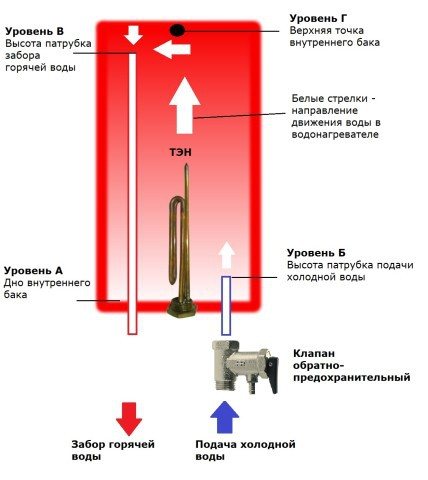

In most electric storage water heaters, temperature sensors are installed, with the output of readings on an electronic display or a mechanical thermometer. Cold water is supplied through a tap with a safety check valve. Boiler operation modes are controlled by both electronic modules and mechanical regulators in simpler models. The advantages of storage electric water heaters include the ability to heat large masses of water and low energy consumption, and the disadvantages are high cost.
Advantages and disadvantages of water heaters
Above, we talked about how an electric storage water heater works. Many of you may say that the cost of an 80L electric storage water heater is very high. But the price can be offset by its most important advantage - saving money. This happens if, when using a boiler, you simply do not pay for hot water. Moreover, this is of great relevance for those people who have meters installed in their house or apartment. In this case, only cold water and electricity are consumed. As for the latter, then in a minimum amount.
- Different models of water heaters can have different features. Horizontal flat storage water heaters of 80 liters have the following advantages:
- Compact dimensions. A flat boiler will take up several times less space than a round one. You can easily install it on the floor, on the wall in the kitchen, or anywhere else. The flat model of the heater is an excellent rhenium for an apartment with a small area.
- Maintaining the water temperature. In addition to all the advantages, the storage type flat, round heater has a Thermos function. This means that the cooling of the water is slow. This means that you do not need to heat up the water every time you need to wash the dishes or take a shower.
- For each water heater, the plant issues a two-year warranty. Proceeding from this, in the event of a breakdown, you have the right to contact the service center for repairs completely free of charge.
If we talk about the disadvantages of flat boilers, then, of course, much here will depend on the model. For example, if the heater is a flow-through type, then you can forget about saving electricity, since the water will be heated in the direction of its movement. This means that the energy for heating will be used as long as the water is flowing. Accumulative boilers in this case are much more profitable, for example, you can use heated water only once for a long time without turning off the heating element. Many developers specifically reduce the energy efficiency of flat types of heaters to reduce their overall size. Based on this, you do not need to buy a very small model, most likely, it will be ineffective.
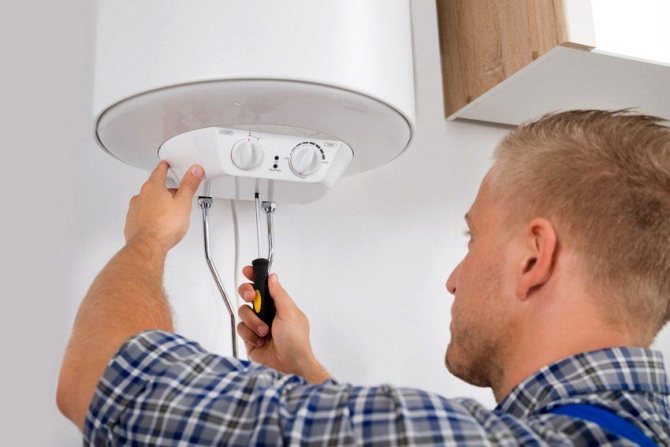

What to look for when choosing a boiler
Each boiler has certain pros and cons. But there are several points that you just need to pay attention to when choosing all kinds of water heater options:
- Mechanical control of the device will always be more reliable than electrical control, since an electrician can damage the entire equipment in the event of accidental power surges.
- The enamel coating is the most effective as it can prevent corrosion at the weld. There is another great advantage of enamel - low electrical conductivity. As a result, the enamelled tank will not corrode the seams.
- It is best to determine the volume of the water heater in advance, having approximately calculated how much water you intend to use per unit of time. A very small tank will not be able to meet your needs if you have a large family. But at the same time, a tank of 80 liters in a house for one person will consume a lot of unnecessary electricity.
- A heating element that will not be in direct contact with water will serve you much longer. This is due to the fact that scale does not begin to form on it. There is one more advantage of a dry heating element - not to drain the water from the tank.
- Any heating device requires constant maintenance, regardless of the frequency of its use. The more often you check the device for breakdowns and replace parts that are out of order, the longer the device will be able to serve you.
- If you buy a boiler from your hands, then you will not be issued a warranty card and you have big risks of buying low-quality equipment.
- The boiler must be installed by professionals. If you want to install a flat, vertical or other heater for 80 liters, then this can lead to its breakdown, and as for the warranty, it will no longer be valid.
It is worth noting that the devices of a barrel-shaped or flat boiler of the same volume will not differ from each other. So, when choosing its shape, you should be guided by the availability of free space in the house. An 80 liter flat vertical storage water heater will be a more suitable option for a small house or apartment.
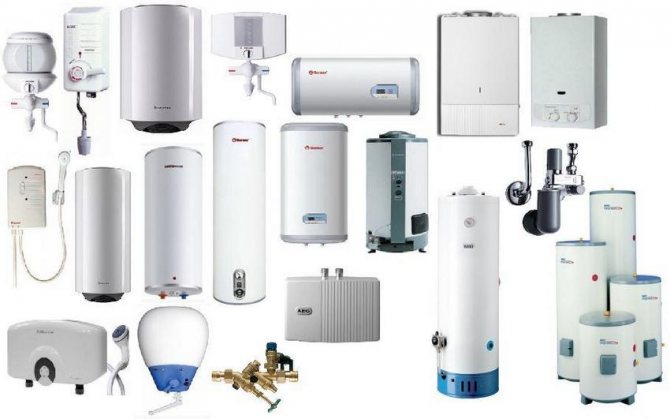

Popular models and their characteristics
An 80 liter heater will be the best option for a family of two or three people. The characteristics of boilers, their cost may vary It depends on the manufacturer. Below in our article we will tell you about the most popular models. In addition to all of the above models, there are still a huge number of inexpensive and very reliable models of 80l boilers. In this case, the choice will depend on your own preferences in relation to one or another manufacturer and several factors. If you cannot choose the model you need on your own, then it is better to seek advice from an experienced specialist.


Boiler maintenance
If a boiler is installed, then you need to know how to care for it. To extend the service life of the water storage heater, you need to constantly carry out technical inspection and change parts. A very common problem is the formation of scale on the heating element. This can be completely avoided by installing special water filters on the inlet pipe, or by constantly replacing the heating element.
In addition, problems with the tank can twist if there are a large number of seams on it, which will be problem areas due to the formation of corrosion. This will be relevant for vertical, flat Termeks 80 liters boilers.
https://youtu.be/NXTujd3XLuc
Instantaneous water heater
The device of an instantaneous water heater is completely different from the operating principle of storage equipment. This device does not have a tank for storing water, and it is heated with a constant flow of liquid through the heating module. As such a module, a structure made of pipes with heating elements is used, which can be located both outside and inside the structure. The best material for making a heating module is copper, but in cheaper models stainless steel or aluminum can be used.
In addition to the module for heating water, the device includes various additional devices. A water flow sensor is required to determine the minimum water pressure at which the water heater can be operated.Temperature sensor, temperature controller (thermostat) are designed to control operating modes. A thermal fuse shuts down the system when the maximum possible water flow temperatures are exceeded. The picture below shows a classic cross-sectional diagram of an electric instantaneous water heater.
Brief historical background
In 1760, the Swiss Saussure invented a solar water heater. He took two containers of water and placed them in an insulated pine box, covered with glass on top. Sunlight, breaking through the glass, hit the black lining of the box, which, when absorbed by the sun, turned it into heat, causing the water to heat up. But that was just an experience. In 1891, the United States produced the first solar water heater for sale.
The first domestic water heater was invented by the English artist Moen in 1868working on solid fuels. The invention was named a geyser after a hot spring in Iceland. The device heated the water flowing through the pipes with hot gases from the burner, which was located at the bottom, and the water flowed into a bath or a substituted vessel. The invention was left without a future, since it did not have a chimney and was a danger to humans.
In this video, you will learn the diagram for connecting the boiler to the water supply:
https://youtu.be/i7Tt_zqVh7Y
A series of experiments on the invention of a water heater have been undertaken in Europe and the USA. At the end of the 19th century, Americans were already selling their first gas water heaters, and later the Norwegian engineer Edwin Rood, having emigrated to the United States, created a gas storage water heater, which is still actively used in America. In 1905, one of the European companies produced the world's first gas water heater, the inventor of which was the German engineer Johann Weiplant.
Since then, the gas water heaters have hardly changed, but their security system has improved. In 1987, the first electronically controlled electric water heater went on sale in Berlin.
Storage electric heaters were first mentioned in the 1930s. But only in the mid-90s, the French company Atlantic developed and improved the dry heating system.
In Russia, in the 40s, the production of gas flowing water heaters began. In the 90s, electric ones began to be imported from abroad, which are still popular today.
Electric water heater market overview
Currently, there are more manufacturers, both domestic and foreign, on the Russian market for electric water heating equipment. Of course, mainly foreign manufacturers such as MTS and Lorenzi Vasco dominate, but you cannot call their products pure imports. Most companies open their own full-cycle production facilities in Russia, with the manufacture of basic components. This allows you to reduce the cost of production and make it available to a wide range of buyers. One of these companies is the Italian corporation Thermex, whose products have practically become a Russian brand.
For more than twenty years it has been successfully working in Russia, opening its own factories and providing our market with high quality electric water heaters. The range from this manufacturer includes all types of electrical equipment for water heating. The popularity of the Termex water heater among consumers is very high due to the innovative ideas used in its manufacture. The principle of operation of the Termeks water heater, regardless of the type of device, does not differ from similar products from other manufacturers.But it should be said right away that the company's products have won the trust of the Russian buyer with their technical characteristics and affordable prices.


Why are water heaters from the "Termeks" corporation so good? Everything is very simple! The range of products is very wide and allows almost any consumer to choose equipment for heating water according to their needs. Electric storage water heaters Termeks are produced in a wide range of internal volumes from 10 to 300 liters. Flow-through heaters of various capacities allow you to almost instantly heat flowing cold water to the required temperature.
Other advantages of Termeks electric water heaters include the following technological and design features:
- the range of storage water heaters consists of both round and flat models of various sizes with a laconic design;
- high-quality thermal insulation of products and automatic control of operating modes can significantly save energy;
- in various models, both electronic and mechanical control are used, which allows you to optimize the entire process of heating water;
- storage water heater tanks are made of special stainless steel with high corrosion resistance;
- in instantaneous water heaters, the heating module is completely made of copper, which increases its reliability and durability;
- in some models of storage water heaters, the inner surface of the tanks is covered with bioglass porcelain, which completely eliminates the corrosion of the tank.
In addition, the product range includes electric water heaters with a combined water heating system.
The device and the general principle of operation of the storage water heater
The general device of a storage type water heater is the same for any model. The boiler consists of a water tank, which is enclosed in a decorative casing, and a heater is laid between them. It looks like a thermos. The main difference between storage boilers is what kind of heater they have: an electric heating element or a gas burner.
There are storage water heaters for indirect heating, where a coil connected to the heating system serves as a heater. Such boilers turned out to be practically not in demand. Heating does not work all year round, which means that a person does not have the opportunity to use hot water in summer.
Accumulative heaters differ according to the type of installation. Vertical boilers take up a lot of space, which is why they are placed in a spacious room. For a small room, a horizontal water heater is more suitable. The last option is inconvenient in terms of use. In the case of a horizontal boiler, the hot and cold layers of water are quickly mixed. As a result, when you open the tap, boiling water flows, and after about a minute, cooler water begins to flow.
General device of the boiler
Let's look at what the diagram of a conventional storage type water heater looks like:
- The boiler is based on a tank. In household models, its capacity is limited to 300 liters. The tank is made of stainless steel or steel. To prevent the metal from rusting, glass enamel, glass porcelain or titanium sputtering is used as an internal coating.
- The water tank is enclosed in an external decorative casing. It can be made of stainless steel, ordinary enamelled steel or plastic.
- The space between the storage tank and the outer casing is filled with heat-insulating material - polyurethane foam.
- The front area of the outer casing of the water heater is equipped with a thermometer.
- The heart of the storage boiler is the heater. An electric water heater operates from a built-in element - heating element (tubular electric heater). Gas storage water heaters are equipped with a burner and a chimney.
- Hot and cold water pipes come out at the bottom of the storage boiler.A safety valve is installed on the cold water pipe, as well as a check valve. The first one opens from excess water pressure inside the tank. The second - does not allow water to leave the tank in the absence of pressure in the water supply system. The hot water pipe is connected to the intake pipe.
- The electronic unit is designed to control the operation of the storage water heater. It receives a signal from a thermostat, the sensors of which are installed inside the tank.
- The magnesium anode protects the steel tank of the boiler from galvanic corrosion by releasing ions.
Installation and operation of any storage water heater does not cause any difficulties for the user. The device is attached to the wall with brackets. The supply pipe can only be connected to a cold water supply. This is the principle of the boiler operation, since it is cold water that heats up in it. If the input of the storage water heater is connected to the centralized hot water supply of the apartment, then the correct temperature achievement after supplying the hot water to the tank will become impossible.
Principle of operation
The basic principle of operation of a storage water heater is the layer-by-layer separation of liquids of different temperatures. According to the law of physics, warm water is at the top, and cold water is at the bottom. For a complete understanding of how the boiler works, we will consider all the steps in order:
- When you open the water tap, water starts to flow. The upper layers of hot liquid from the boiler tank are directed through the intake tube into the pipeline.
- The pressure inside the water heater tank becomes less than in the supply water pipe. The non-return valve opens and the cold water supply begins. When the pressure of the water supply and inside the tank is equal, the check valve closes. During make-up, cold water does not mix with hot water thanks to a divider installed at the end of the supply pipe.
- A sensor signals the entry of cold water into the water heater tank. He instructs the control unit to turn on the heating.
- Electricity is supplied to the heating element, and the water is heated to the set temperature. With a gas water heater, gas is supplied to the burner instead of electricity. When the water reaches the desired temperature, the thermostat turns off the heating element.
Basics of operating a water heater
The whole process of boiler operation consists of three stages:
- Filling the boiler with cold water.
- Heating this water to the temperature you set,
- Distribution of already heated water for the intended purposes.
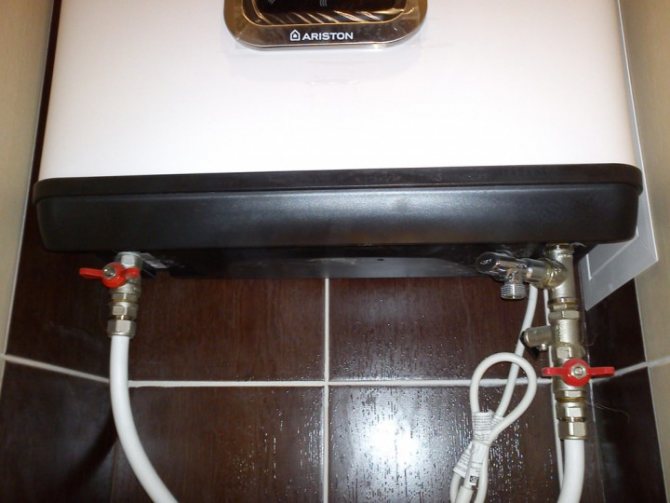

When the boiler is turned off, the normal water supply from the taps must be restored
How to fill the boiler and turn it on
The sequence of actions required to get started is simple.
- We turn off the common hot water supply tap from the main supply system. This will prevent the flow of heated water from the device back into the main pipe.

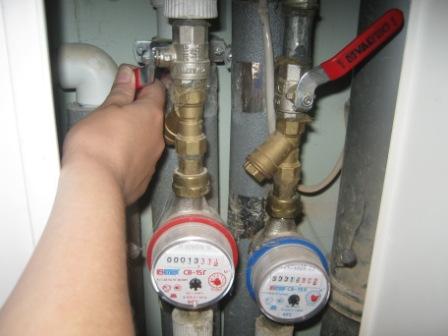
Before using the boiler, turn off the hot water tap on the riser - We open the hot water valves in the kitchen and bathroom, draining the water remaining in the system.
- Then we fully open the taps that supply hot and cold water to the boiler. We fill the tank, shut off the water.
- We connect the boiler to the outlet (the indicator light must come on). Using the thermostat switch, we set the heating program we need. We put the device into operation.
- By turning the thermostat, we will be able to regulate the water temperature from the minimum to the maximum marked on the thermostat knob. When the set heating value appears on the thermostat, the device will beep with a lit indicator light.

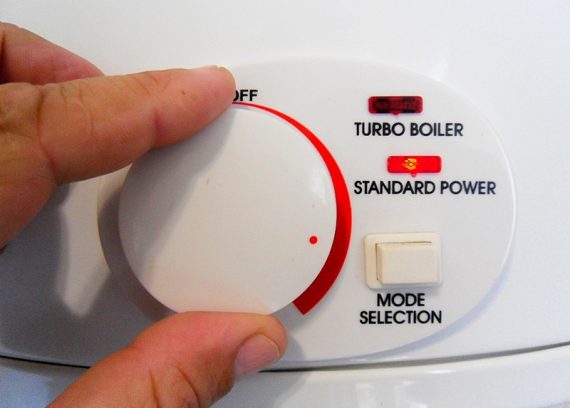
With the help of a thermostat, we achieve water heating to the desired temperature - Just in case, we inspect the pipes for leaks. Now you can use hot water at your own discretion.
When you start up the machine in heating mode, make sure that it is filled with water as much as possible.Turning on an empty boiler in this mode will lead to its instant breakdown.
If the water in your area is "hard" (high in salt), it is recommended to install a magnetic softener at the boiler inlet or insert a filter. They slow down the corrosion process and help to increase the life of the device.
How to turn off the water heater
To turn off the boiler, you need to do in the reverse order all the steps taken when it is turned on. That is, return the normal flow of water from the central pipe to the mixers.
- We stop the heating program carried out by the appliance. We disconnect it from the network.
- We close both water taps (cold and hot) going to the boiler.
- We leave the water heater in this position until there is a need to use it again.
- We open the tap of hot water coming from the main pipe of the system.
While the heater is in operating mode, do not disconnect it from the mains under any circumstances.
It is undesirable to turn on and off the water heater very often. This can lead to failure of the entire automation of the device. If you are heating water daily, it is best not to turn off the boiler at all. Its complete shutdown is recommended only in case of prolonged non-use.
Video: switching the boiler on and off by time
How to set up a boiler
The more we heat the water in the boiler tank, the more water of the required temperature we will receive when mixed with cold water. If the demand for hot water is low and you have water meters installed, it will be convenient to set a temperature mode that allows you not to dilute the water at all. Thus, we will save both water and electricity.
The recommended optimum water temperature is 55 ° C. At this degree of heating, the lowest rate of scale build-up. Temperatures below 55 ° C also do not always have a good effect on the device. For example, water at 30–40 ° C is an ideal medium for the growth of bacteria, leading to fungal infections of the tank walls. In such cases, water acquires a stubborn moldy smell.
The device and principle of operation of an electric boiler
Electric water heaters are considered the most popular among residents of apartments and private houses. The popularity is due to the ease of installation and operation. The diagram shows a sectional view of the storage water heater device. Let's take a look at what an electric boiler looks like from the inside:
- We will begin to consider the device of a storage electric water heater with a tank. It is round or oval in shape. The tank is enclosed in a decorative casing. The inner space between the two containers is filled with polyurethane foam.
- A feature of the electric water heater device is the presence of a heating element. The element is installed at the bottom of the boiler tank on a flange connection.
- The thermostat controls the heating element on and off. Any storage water heater works without exceeding the maximum permissible temperature. For electric boilers, this figure is 75 o C.
- The water heater is protected. In case of failure of the thermostat, the heating element will be de-energized when the critical water temperature reaches 85 o C.
- Hot water is drawn through a pipe, the end of which is brought out to the top of the boiler tank. A branch pipe is mounted at the bottom of the tank for feeding cold water.
- The magnesium anode protects the tank body from corrosion. After 2-3 years, the element collapses and needs to be replaced.
- The operation of the water heater is signaled by an indicator lamp.
Knowing how the boiler works, you can understand its work. Cold water enters the inside of the boiler tank through the pipe. The sensor sends a signal to the control unit, which, using a thermostat, supplies voltage to the heating element. The water heats up to the set temperature. The sensor gives a new signal and the thermostat interrupts the power supply. After drawing hot water, the cycle repeats.
Varieties of heating elements
By the principle of operation, the heating elements are the same. A spiral acts as a heating element. But according to the execution of the heating elements, they differ and are divided into two types:
- Wet heating element consists of a spiral, hermetically sealed inside a copper tube. Quartz sand is used as a filler. It acts as an insulator and prevents the coil from touching the inner walls of the copper tube. The advantage of wet heating elements is low cost. The disadvantage is its large size and low electrical safety indicator. If the copper tube is damaged or the coil touches it, a breakdown occurs. As a result, a person using hot water receives an electric shock.
A storage water heater with a dry heating element is more expensive, but it is safer and has a long service life. Compact dimensions allow two heaters to be installed in the boiler. The most reliable is a dry heating element, the typesetting body of which is made of soapite.
How to turn on the boiler (water heater)? Procedure
In the modern world, people are accustomed to comfortable conditions and therefore try to create the most comfortable space around them.
In order not to worry about interruptions in the supply of hot water, many decide to install a water heater. But due to rare use, not everyone knows how to turn on a boiler of a particular brand.
In fact, it is not difficult at all and, observing a certain order of actions, you can cope with the task yourself.
Boiler advantages
Hot water in the house is not a luxury at all, but a necessary condition for comfort. However, residents of city apartments often face the fact that in the summer, hot water is disconnected from the centralized supply for repair work. This forces many people to install boilers - containers that allow them to heat water and use it in the local plumbing system.
The advantage of this type of heater is that they can be installed in almost any, even the smallest room. Modern models consume little electricity, which saves the family budget. And the most important plus is that there will always be a supply of hot water in the house.
Such devices are quite simple to operate, but with irregular use, you can forget how to turn on the boiler correctly. The diagram is the same for most models.
And subject to a certain sequence of all actions, the water heater will serve its owner for a long time.
You can turn it on yourself if you have instructions, or you can contact a specialist for help.
When it is already installed and connected to the water supply system, it is necessary to make a test run and check the operation of the boiler. In fact, there should not be any difficulties with this, and the process itself does not require special skills.
First of all, it is necessary to turn off the valve of the centralized hot water supply to the apartment. This will prevent heated water from leaving the common riser. Otherwise, all residents of the entrance will use the water from the boiler. The manipulation is also performed if there is a check valve.
Almost all models of heaters on the market (Thermex, Timberk, Electrolux, Ariston and others) are switched on in the same way.
Procedure
How to turn on the boiler so that hot water appears? To do this, follow the steps listed below in the following order:
- Open the hot water tap on the mixer and make sure it is not there. Shut off valve.
- Open the tap with a blue circle at the inlet of the water heater, then the tap at the outlet, marked with a red mark. Wait for a while until all the air is released from the system, if there was no water in the boiler. Next comes the process of filling the water heater.
- In the event that the boiler was filled with water, you just need to drain it a little and close the tap with a red circle.
- Before plugging in the boiler, the tank must be completely filled with water. Otherwise, there is a risk of burnout of the tubular heater if the model is not equipped with a protection system.
- In the process of heating water, it is important to control the temperature indicator and the voltage supply to the heating element.
Experts advise to set the operating temperature of the device at 55-60 ° C. This will help to avoid the development of fungi and bacteria in the tank, as well as prevent the formation of scale on the heating element.
Boilers are used mainly in the summer, when hot water supply interruptions often occur. If the need for heating with a heater has disappeared, it is important to know how to turn off the boiler and turn on hot water from a centralized system. The process may take a little longer than when connecting the unit.
First of all, the device is disconnected from the mains. Some experts do not recommend storing the water remaining in the tank, while others, on the contrary, say that this way the parts will corrode less. If the water still remains in the tank, it must be drained off before turning on the boiler next time.
It is imperative to shut off the cold water supply to the heater system (tap with a blue circle). After that, the heated liquid outlet valve is closed. The final stage is the inclusion of hot water on the mixer.
Recommendations
The disassembly of the water heater is carried out only after the water has been completely drained from the tank. To do this, disconnect the cold water supply hose to the boiler, and put on a pipe in its place, through which the remaining liquid will come out.
During periods when there is no need to operate the boiler, the device is prevented: the heating element is cleaned from scale, the presence of a coating inside the tank with a magnesium anode is determined (protection against corrosion). It is best to do this once a year (on your own or call a specialist) in order to extend the life of the water heater.
Source: https://FB.ru/article/320340/kak-vklyuchit-boyler-vodonagrevatel-poryadok-deystviy
The device and principle of operation of a gas appliance for heating water
In terms of the structure and principle of operation, a gas boiler is slightly different from its electric counterpart. The same tank enclosed in a casing with polyurethane foam insulation is inherent in a gas water heater. The anode serves as protection. Cold water is supplied and hot water is drawn through the pipes mounted in the tank. The heating is switched on and off by a thermostat. This is where all the similarities end. Guided by the diagram, we will take a closer look at the boiler device in order to identify the main differences between the gas appliance:
- The main difference from an electric boiler is the presence of a gas device for heating water - a burner.
- The connection to the gas main is carried out through the block. A reducer is installed inside it, which is connected by a tube to the burner nozzle.
- The design of the storage water heater tank differs significantly from the electric analogue by the presence of a chimney. It consists of a steel pipe welded vertically through the entire tank. From above, the chimney is connected to an exhaust hood. Through it, combustion products are removed to the street.
- A splitter is installed inside the chimney. Its plates take away the heat of the exhaust gases and give it back to the water. It turns out double heating: from the burner and the divider.
- Due to the temperature difference between the cold water and the burner flame, condensation forms in the chimney. To collect it, a ring is installed under the burner.
A gas water heater works according to the same principle as an electric boiler. The only difference is that an electronic unit with a thermostat controls the operation of the burner. When the temperature drops, gas is supplied to the nozzle and ignition occurs. When the water temperature reaches the set parameters, the burner turns off.
Gas water heaters are in low demand due to the complexity of the installation. It will be necessary to draw up a project, and installation is allowed only by specialists of the gas service. However, the indisputable advantage is the savings due to the lower gas price.
Of the two options considered, the first place is given to electric storage water heaters. The device can be independently installed in any place. The main thing is to ensure an uninterrupted supply of cold water under pressure.
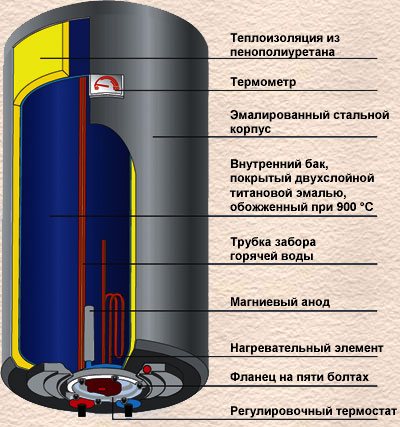

An electric storage-type water heater, or, in a simple way, a boiler, has long and firmly entered our life, providing additional comfort and allowing you not to depend on communal hot water supply systems. This simple device automatically maintains the required water temperature, while having a certain supply of it. The devices produced by the industry have a variety of shapes, sizes and external designs. Despite the apparent differences, at their core, all water heaters have a similar design and a single principle of operation. However, when making a choice between a particular model of a boiler, one should not only understand how it works, but also understand the features of the execution of some of its components.
How to properly use an already operating water heater?


Example 3 of connecting an electric water heater.
You should be aware that the boiler must not be disconnected from the electric current during operation. If hot water is temporarily not needed, then the device can be turned off from the outlet. This will save you energy.
However, many experts argue that if the boiler is constantly filled with heated water, then it does not undergo destruction (corrosion). In addition, it is much easier for the device to set the required temperature than to start heating from zero. In order to prevent a fire hazard, be sure to ensure that the appliance is grounded.
Flow-through boilers have no restrictions on the amount of heated water. Usually they are used at a time only in one place (where they wash the dishes or take a bath). If you fully open the tap, the water in the water heater will not have time to heat up. In order to reduce heat loss, the boiler should be installed as close as possible to the place where hot water is used.
If hard water is supplied to the house, then it is necessary to install a water purification device, because otherwise the water heater will fail very quickly. If the device is installed in a sauna or bath, then you need to ensure that no drops of liquid fall on it. It is impossible to use a flow-through electric boiler in those houses where the air temperature often drops to zero.
Boiler design
In fact, any water heater of this type is a large thermos with a tubular electric heater (TEN) inside, so the design of all boilers has the following elements:
- external casing with parts that allow the device to be mounted on a wall or floor;
- internal tank;
- a heat-insulating layer between the inner container and the body;
- tubular electric heater;
- thermostat with the ability to adjust the heating temperature;
- safety valve;
- protective magnesium anode;
- control and indication circuit.
When choosing a boiler, one cannot fail to notice a big difference in price, even between different models of the same manufacturer. It is primarily due to the technology and material used to manufacture the internal tank, as well as the presence of an electronic control and display unit.
These parameters determine the convenience of using the device, as well as the duration of its service.
Housing
Cases of water heaters have both strictly cylindrical and oval and even rectangular shapes, various colors and design designs. Often a thermometer is attached to the outside of the housing to monitor the operation of the device, as well as regulators or control elements. The housings are made of steel sheet or plastic.
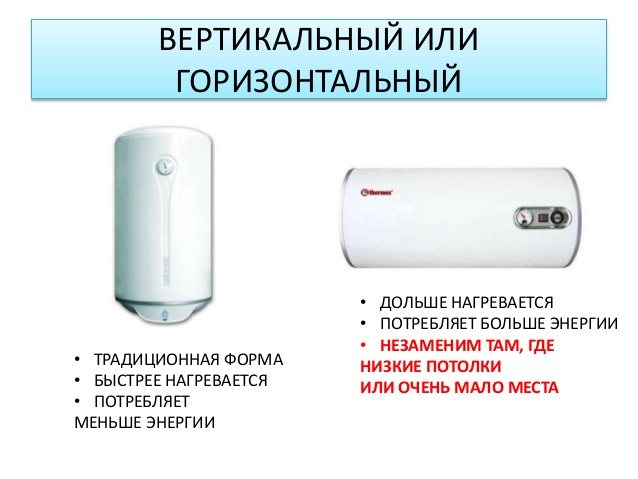

Features of vertical and horizontal boilers
Inner tank
The design of the internal tank of the boiler must meet the criterion of increased corrosion resistance and at the same time withstand constant temperature changes, therefore, manufacturers pay a lot of attention to this element, developing new tank coatings and applying methods of its protection.
Steel tanks coated with glass enamel or glass porcelain
Such a coating is obtained by spraying a protective layer with its subsequent firing at a high temperature (up to 850 ° C). Glass enamel is not capable of oxidation, therefore it does not corrode at all. In addition, its smooth surface resists limescale build-up.
Paradoxically, the main disadvantage of such a coating stems from its advantage - the high hardness of the layer is low-plastic and over time, constant changes in water temperature lead to the formation of microcracks in its layer, which ultimately contribute to the destruction of the tank.
Manufacturers are constantly looking for new formulations for this type of coating. For example, the addition of titanium powder equalized the temperature coefficients of expansion of glass porcelain and steel, slightly improving the resistance of the layer to cracking. It is possible to slightly reduce the harmful effect of temperature exposure by setting the water temperature in the boiler to no higher than 70 ° C, although all the same, at least once a month, you will have to warm up the device as much as possible in order to comply with sanitary rules. Another disadvantage of the glass-porcelain coating of the tank can be considered the increased weight of the boiler. Companies producing water heaters with tanks of this type give a guarantee for their products for no more than 3 years.
Titanium coated steel tanks
By spraying titanium powder onto the inside of the tank, excellent corrosion resistance is achieved. At the same time, this type of coating has high strength and mechanical resistance, having weak points only at the welding joints. The warranty for a device with such a tank is up to 10 years, which is a huge advantage, even if you take into account its rather high cost.
Stainless internal tanks
Such containers are devoid of the disadvantages of the two previous elements. Stainless steel, like titanium, is able to withstand the effects of impurities in the water, as well as corrosion. It is believed that stainless steel gives water a peculiar smell and taste that appear during its heating, but this is just speculation, absolutely not confirmed by scientific research. It is known that "stainless steel" does not enter into a chemical reaction with water. Manufacturers also give up to 10 years warranty for such tanks, but they are the most expensive ones. Tanks made of stainless steel, as well as those with titanium spraying, are more susceptible to scale formation than glass porcelain, but this does not detract from their merits in the least. The inner tank contains pipes for supplying cold water and removing hot water, as well as an electronic heating and protection unit.
Heating and protection unit
The elements responsible for heating water to a certain temperature, as well as protecting the metal of the inner tank from destruction, are installed on a metal flange, which is connected by means of a seal to the inner tank of the device.


An example of a control unit
Heating elements of various capacities are used to heat water. Depending on the heating principle, a distinction is made between:
- "Wet" heating elements, which are in direct contact with water, therefore inevitably become covered with scale, which must be periodically removed, otherwise the heating element will fail due to overheating;
- dry type heaters. Devoid of this drawback, since they are installed in a metal tube, which makes contact with the liquid. This scheme allows you to get rid of scale not only on the heater, but also on the tube covered with a layer of glass porcelain.
Some boiler models are equipped with several heaters. This design allows for stepwise regulation of heating, and also reduces the number of switching cycles for each of them (voltage surges during switching on of devices affect their durability).
Together with heating elements, a thermostat and a magnesium rod (anode) are installed on the flange. The thermostat is responsible for turning on the heating element when the water temperature drops below the set by the consumer. Thermoregulators of both mechanical type and electronic devices operating in conjunction with an electronic control unit are used. Often, the thermostat device includes a safety shutdown circuit for the heating element in the absence of water in the tank. The magnesium electrode is designed to reduce the exchange of ions of metal components inside the boiler, giving up its own particles in return. Such a scheme reduces the effect of elution of electrons from structural elements and they corrode to a much lesser extent. At the same time, the magnesium rod itself collapses rather quickly and requires periodic replacement (when thinning to 10 mm or reducing the length to 200 mm). The control and indication circuit provides additional convenience when using the water heater, having the functions of precise adjustment of the water temperature, switching on heating by time, maintaining a different degree of heating depending on the time of day.
How to switch the water heater and connect the hot water?
In the modern world, people are accustomed to comfortable conditions and therefore try to create the most comfortable space around them.
In order not to worry about interruptions in the supply of hot water, many decide to install a water heater. But due to rare use, not everyone knows how to turn on a boiler of a particular brand.
In fact, it is not difficult at all and, observing a certain order of actions, you can cope with the task yourself.
How to turn on the boiler?
When it is already installed and connected to the water supply system, it is necessary to make a test run and check the operation of the boiler. In fact, there should not be any difficulties with this, and the process itself does not require special skills.
First of all, it is necessary to turn off the valve of the centralized hot water supply to the apartment. This will prevent heated water from leaving the common riser. Otherwise, all residents of the entrance will use the water from the boiler. The manipulation is also performed if there is a check valve.
Almost all models of heaters on the market (Thermex, Timberk, Electrolux, Ariston and others) are switched on in the same way.
How do I turn on the hot water again?
Boilers are used mainly in the summer, when hot water supply interruptions often occur. If the need for heating with a heater has disappeared, it is important to know how to turn off the boiler and turn on hot water from a centralized system. The process may take a little longer than when connecting the unit.
First of all, the device is disconnected from the mains. Some experts do not recommend storing the water remaining in the tank, while others, on the contrary, say that this way the parts will corrode less. If the water still remains in the tank, it must be drained off before turning on the boiler next time.
It is imperative to shut off the cold water supply to the heater system (tap with a blue circle). After that, the heated liquid outlet valve is closed. The final stage is the inclusion of hot water on the mixer.

